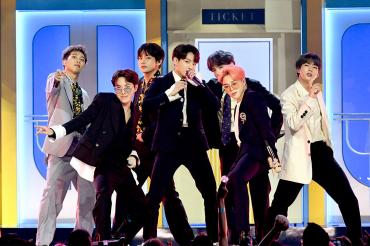K-pop, fandom and the BTS boys: U of T researcher brings ‘Korean Wave’ into classroom

Published: August 29, 2019
If you’ve tuned into a late night show, listened to the radio or logged onto Twitter lately, it’s likely you’ve heard of Korean boyband BTS, or at least come across the name.
The K-pop darlings have performed on Saturday Night Live, sold out New York City’s 40,000-seat Citi Field and topped the Billboard charts – all while inspiring a devoted, global and cross-cultural fan base.
So it’s no wonder that Michelle Cho, an assistant professor in the University of Toronto’s department of East Asian studies in the Faculty of Arts & Science, is captivating students with her courses on Korean film, media and popular culture.
“The really unique thing about East Asian studies is that it’s interdisciplinary by design,” says Cho. “You have students coming from all across the arts and sciences. My courses attract students who have an interest in Asian pop culture.”
It’s not only students who are interested. North Americans in general have demonstrated a growing interest in Korean pop culture in recent years, part of the global “Korean Wave.”
In her courses exploring fandom and transmedia – storytelling across multiple platforms – Cho allows her students to bring their own expertise as fans to the classroom, which she says has been useful as a researcher of fandom culture.
At its most basic level, the term “fandom” is used to describe a subculture or community formed around a collective love of something in the pop culture sphere. Whether it’s a sports team, TV show, book series, movie franchise or band, fandom is a shared love of something that builds community – often online – and becomes a significant part of a person’s identity.

Michelle Cho is an assistant professor in U of T’s department of East Asian studies (photo courtesy of Michelle Cho)
Cho’s research addresses a phenomenon that’s becoming more engrained in our modern lives.
“You see fandom culture becoming much more important in the way that people define themselves in a media landscape that can seem very fragmented,” says Cho. “In a way, everybody has their niche little worlds online, or on media platforms.”
It’s the idea of finding likeminded people online that makes way for fandoms to blossom.
“We have this sort of infinite seeming choice of what kind of media we consume. I think it makes a lot of sense that the communities that form around those choices become much more significant,” Cho says.
“Fandom helps people to find a form of collective identity that seems more open and expansive than the kinds of group identities that are ready-made like national identity or generational identity.”
While the stereotypes of fans haven’t changed much since the days of Beatlemania – think hysterical young women and geeky young men – Cho says K-pop fans are more diverse than you might think. And she says it’s even more surprising that they tend to be self-reflexive in a way that contradicts what’s been understood historically about fandom.
“Reflexive awareness is thought to make you less emotionally invested and more neutral,” says Cho. “So self-critical consumers of popular culture should be a completely different group than the fangirls and teens swooning at concerts, right? But they're not. They're the same group.
“I’m really interested in looking at how self-reflexivity makes fans more invested in their love object.”
Cho also looks at the types of media technologies that enable K-pop fans to communicate with others in their community, as well as feel a sense of intimacy with their idols – even if that intimacy doesn’t really exist.
Take, for instance, V Live.
It’s a popular app – and one that the members of BTS use regularly – that mimics Apple’s FaceTime or other livestreaming apps that create a kind of digital intimacy between users.
Except unlike FaceTime, there’s no back-and-forth conversation. It’s a way for K-pop stars to open their lives up to their fans in a way that makes them seem ordinary and approachable, even if they’re not.
The tactic is used outside the world of K-pop as well.
Cho says you can even see U.S. politicians following suit by using their social media channels to create a sense of intimacy with followers.
U.S. Representative Alexandria Ocasio-Cortez is one high-profile example. The young Democratic congresswoman – known for her progressive views – made headlines during her first months in Washington for talking directly to her 3.2 million followers on Instagram Live while assembling IKEA furniture, making chili and drinking wine.
It’s that direct-to-camera intimacy – feeling like you’re chatting with a friend – that Cho says K-pop stars have become known for when it comes to fan interaction.
As for whether we have K-pop stars like BTS to thank for Korea’s increased visibility in the North American zeitgeist, Cho says they certainly play a part.
“I think that the rising interest in Korean language, culture and history – and just Korean studies in general – is coming from the increased visibility of Korean pop culture,” said Cho. “When I was growing up in the U.S., and even in college, a lot of people didn't actually know that Korea was a separate country from Japan or China, which is hard to believe now.
“But that just says something about Korea’s visibility. And the fact that it's in people's consciousness, whether or not they have anything to do with Asia or know any Koreans. It has a lot to do with media representation.”
While Cho’s research into K-pop fandom will continue, this year she’s returning to her research roots by teaching a course on Korean cinema, as well as a first-year foundation seminar that explores how media producers and fans engage with media worlds in East Asia.



